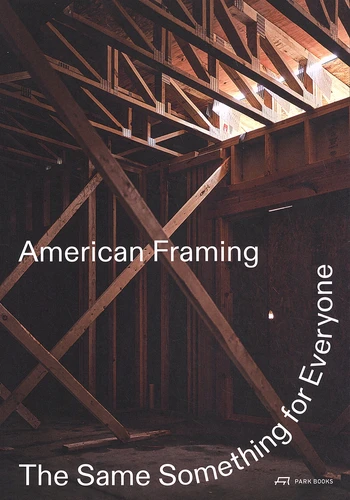American Framing. The Same Something for Everyone
Par : , ,Formats :
- Paiement en ligne :
- Livraison à domicile ou en point Mondial Relay indisponible
- Retrait Click and Collect en magasin gratuit
- Réservation en ligne avec paiement en magasin :
- Indisponible pour réserver et payer en magasin
- Nombre de pages250
- PrésentationBroché
- FormatGrand Format
- Poids1.025 kg
- Dimensions21,0 cm × 30,0 cm × 2,0 cm
- ISBN978-3-03860-195-1
- EAN9783038601951
- Date de parution15/03/2023
- ÉditeurPark Books
Résumé
From its origins in the Midwest in the early nineteenth century, the technique of light timber framing-also known at the time as "Chicago construction"-quickly came to underwrite the territorial and ideological expansion of the United States. Softwood construction was inherently practical, as its materials were readily available and required little skill to assemble. The result was a built environment that erased typological and class distinctions : no amount of money can buy you a better 2x4.
This fundamental sameness paradoxically underlies the American culture of individuality, unifying all superficial differences. It has been both a cause and effect of the country's high regard for novelty, in contrast with the stability that is often assumed to be essential to architecture. American Framing is a visual and textual exploration of the social, environmental, and architectural conditions and consequences of this ubiquitous form of construction.
For architecture, it offers a story of an American project that is bored with tradition, eager to choose economy over technical skill, and accepting of a relaxed idea of craft in the pursuit of something useful and new-the forming of an architecture that enables architecture. With contributions and texts by Pablo Alvarado and Harold Meyerson, Paul Andersen, Catherine Caufield, Penelope Dean, Dan Handel, Rebecca Gayle Howell, Ania Jaworska, Thomas Kelley and Carrie Norman, Adam Kotsko, Stephen H.
Norwood, Paul Preissner, Daniel Shea, Chris Strong, and Ernest Wilkins. Edited by Paul Andersen, Jayne Kelley, and Paul Preissner. Graphic design by Joe Gilmore.
This fundamental sameness paradoxically underlies the American culture of individuality, unifying all superficial differences. It has been both a cause and effect of the country's high regard for novelty, in contrast with the stability that is often assumed to be essential to architecture. American Framing is a visual and textual exploration of the social, environmental, and architectural conditions and consequences of this ubiquitous form of construction.
For architecture, it offers a story of an American project that is bored with tradition, eager to choose economy over technical skill, and accepting of a relaxed idea of craft in the pursuit of something useful and new-the forming of an architecture that enables architecture. With contributions and texts by Pablo Alvarado and Harold Meyerson, Paul Andersen, Catherine Caufield, Penelope Dean, Dan Handel, Rebecca Gayle Howell, Ania Jaworska, Thomas Kelley and Carrie Norman, Adam Kotsko, Stephen H.
Norwood, Paul Preissner, Daniel Shea, Chris Strong, and Ernest Wilkins. Edited by Paul Andersen, Jayne Kelley, and Paul Preissner. Graphic design by Joe Gilmore.
From its origins in the Midwest in the early nineteenth century, the technique of light timber framing-also known at the time as "Chicago construction"-quickly came to underwrite the territorial and ideological expansion of the United States. Softwood construction was inherently practical, as its materials were readily available and required little skill to assemble. The result was a built environment that erased typological and class distinctions : no amount of money can buy you a better 2x4.
This fundamental sameness paradoxically underlies the American culture of individuality, unifying all superficial differences. It has been both a cause and effect of the country's high regard for novelty, in contrast with the stability that is often assumed to be essential to architecture. American Framing is a visual and textual exploration of the social, environmental, and architectural conditions and consequences of this ubiquitous form of construction.
For architecture, it offers a story of an American project that is bored with tradition, eager to choose economy over technical skill, and accepting of a relaxed idea of craft in the pursuit of something useful and new-the forming of an architecture that enables architecture. With contributions and texts by Pablo Alvarado and Harold Meyerson, Paul Andersen, Catherine Caufield, Penelope Dean, Dan Handel, Rebecca Gayle Howell, Ania Jaworska, Thomas Kelley and Carrie Norman, Adam Kotsko, Stephen H.
Norwood, Paul Preissner, Daniel Shea, Chris Strong, and Ernest Wilkins. Edited by Paul Andersen, Jayne Kelley, and Paul Preissner. Graphic design by Joe Gilmore.
This fundamental sameness paradoxically underlies the American culture of individuality, unifying all superficial differences. It has been both a cause and effect of the country's high regard for novelty, in contrast with the stability that is often assumed to be essential to architecture. American Framing is a visual and textual exploration of the social, environmental, and architectural conditions and consequences of this ubiquitous form of construction.
For architecture, it offers a story of an American project that is bored with tradition, eager to choose economy over technical skill, and accepting of a relaxed idea of craft in the pursuit of something useful and new-the forming of an architecture that enables architecture. With contributions and texts by Pablo Alvarado and Harold Meyerson, Paul Andersen, Catherine Caufield, Penelope Dean, Dan Handel, Rebecca Gayle Howell, Ania Jaworska, Thomas Kelley and Carrie Norman, Adam Kotsko, Stephen H.
Norwood, Paul Preissner, Daniel Shea, Chris Strong, and Ernest Wilkins. Edited by Paul Andersen, Jayne Kelley, and Paul Preissner. Graphic design by Joe Gilmore.


